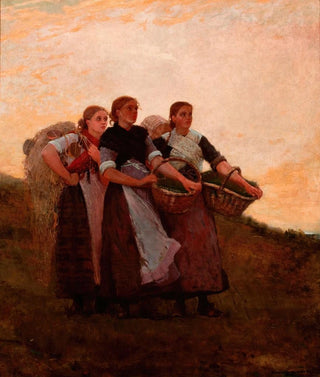Art print | Listen to the lark - Winslow Homer


View from behind

Frame (optional)
Listen to the lark - Winslow Homer – Captivating introduction
In the vibrant world of 19th-century American art, the art print "Listen to the lark" by Winslow Homer stands out for its ability to capture the very essence of nature and human emotion. This painting, imbued with poetry, evokes a bucolic scene where the simplicity of rural life blends with deep contemplation. The artist, known for his keen eye on everyday life, manages to transcend the mundane to offer a visual experience rich in meaning. The art print Listen to the lark - Winslow Homer allows for a new perspective on this work, inviting the viewer to immerse themselves in a suspended moment, where the song of the lark becomes a melody of freedom and serenity.
Style and uniqueness of the work
The art print "Listen to the lark" is characterized by a style that combines realism and impressionism, a signature of Winslow Homer. The brightness of the colors, the finesse of the details, and the dynamic composition create an atmosphere that is both soothing and lively. The characters, although depicted in a natural setting, seem almost to merge with their environment, demonstrating a deep respect for nature. The play of light and shadow, as well as the delicate textures of natural elements, testify to remarkable technical mastery. Each brushstroke seems to be an invitation to listen to the birds' song, to feel the gentle breeze, and to savor the fleeting beauty of the moment. This work, through its apparent simplicity, reveals an emotional complexity that resonates with anyone who lingers on it.
The artist and his influence
Winslow Homer, an emblematic figure of American art, managed to mark his era with an innovative approach and a unique sensitivity. Born in 1836, he was initially an illustrator before turning to painting, a transition that enriched his style. His work is often associated with depictions of outdoor life, where he explores themes of nature, solitude, and humanity. The influence of European impressionism is palpable in his compositions, but it is his personal interpretation that gives him an unmatched authenticity.

Matte finish

View from behind

Frame (optional)
Listen to the lark - Winslow Homer – Captivating introduction
In the vibrant world of 19th-century American art, the art print "Listen to the lark" by Winslow Homer stands out for its ability to capture the very essence of nature and human emotion. This painting, imbued with poetry, evokes a bucolic scene where the simplicity of rural life blends with deep contemplation. The artist, known for his keen eye on everyday life, manages to transcend the mundane to offer a visual experience rich in meaning. The art print Listen to the lark - Winslow Homer allows for a new perspective on this work, inviting the viewer to immerse themselves in a suspended moment, where the song of the lark becomes a melody of freedom and serenity.
Style and uniqueness of the work
The art print "Listen to the lark" is characterized by a style that combines realism and impressionism, a signature of Winslow Homer. The brightness of the colors, the finesse of the details, and the dynamic composition create an atmosphere that is both soothing and lively. The characters, although depicted in a natural setting, seem almost to merge with their environment, demonstrating a deep respect for nature. The play of light and shadow, as well as the delicate textures of natural elements, testify to remarkable technical mastery. Each brushstroke seems to be an invitation to listen to the birds' song, to feel the gentle breeze, and to savor the fleeting beauty of the moment. This work, through its apparent simplicity, reveals an emotional complexity that resonates with anyone who lingers on it.
The artist and his influence
Winslow Homer, an emblematic figure of American art, managed to mark his era with an innovative approach and a unique sensitivity. Born in 1836, he was initially an illustrator before turning to painting, a transition that enriched his style. His work is often associated with depictions of outdoor life, where he explores themes of nature, solitude, and humanity. The influence of European impressionism is palpable in his compositions, but it is his personal interpretation that gives him an unmatched authenticity.






